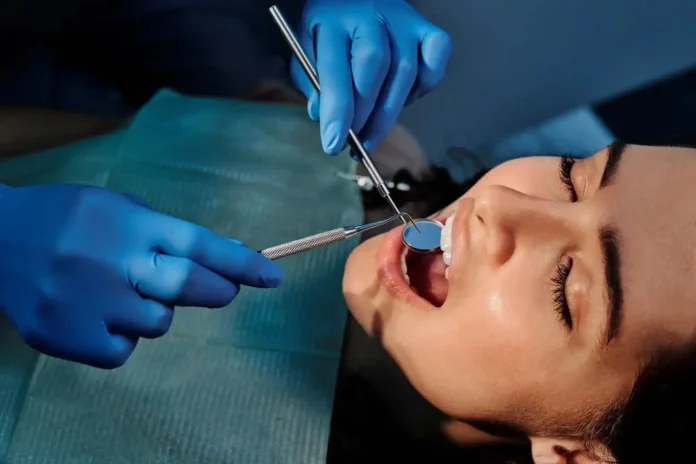The term ‘root canal’ refers to the inner, hollow chamber of a tooth. There’s an outer hard shell to our teeth that we call enamel. The next layer is a slightly soft structure called dentin followed by a hollow space. That hollow space is ‘the root canal.’ As a structure, it contains blood vessels, pulp, and nerves.
Also, different teeth have varying configurations. Some only have one canal while others may have multiple of those. This is the reason why root canal treatment is so varied. In some cases, the treatment can be straightforward. In others, it can be rather complex.
Table of Contents
What’s RCT or Root Canal Treatment?
Treatment of the root canal involves the removal of pulp and nerves from the hollow interior area. After cleaning this area of infected/inflamed tissues, the doctor will fill it up with some kind of biocompatible material. The tooth is then sealed.
Before carrying out the treatment, the operating field must be sterile. To achieve this, your dentist will use a rubber dam, a device that keeps the infected tooth sterile and isolated from the rest of the area all through the procedure.
The device also prevents bacteria from penetrating. your mouth. It also separates any tools/materials that your dentist would use to clean the tooth. In some cases, only one visit to the dentist is sufficient. However, in some cases, two visits may be necessary.
The first one involves cleaning out the pulp and applying medication. The second one involves filling the infected area with a biocompatible material and fillings. Usually, that happens when the tooth is extremely infected demanding a more complex treatment procedure.
When is a Root Canal Necessary?
An RCT may be necessary when the insides of a tooth including the pulp tissues and nerves have become inflamed. The inflammation has reached a point of being irreversible (meaning the medication can no longer heal it).
The thing is – nerves inside a tooth are extremely sensitive and have limited capability to regenerate and/or heal themselves naturally. Because of this, badly injured/traumatized teeth or those or large cavities may have no other option than to go under a root canal procedure.
A lot of people think that a bad toothache may call for an RCT. However, that’s not always the case. In many cases, because the nerves inside a tooth are dead, they may cause no pain whatsoever. The deal tissues, however, do require removal.
Leaving an infected tooth for long may lead to abscess formation. If that happens, you run the risk of spreading the infection not only to neighboring teeth but the entire body as well. So, even if you don’t feel any pain, an RCT is still necessary.
Knowing what symptoms to look out for may help you discern better when to for a root canal treatment. You can also ensure the timely treatment to stop the infection from spreading further.
Common symptoms indicating the need for an RCT are –
- Painful chewing and/or biting
- Gum pimples
- Cracked or chipped tooth
- Tender or swollen gums
- Sensitivity to hot and cold foods
- Deep decay
- Darkening of the gum line
What Should Patients Expect During an RCT?
In case of too much infection, an antibiotic course may be necessary for a few days before the procedure. After the procedure, avoid eating for a couple of hours until the numbing sensation wears off. Otherwise, you run the risk of biting your tongue and cheeks. Also, stick with soft, liquid foods to minimize the chances of hurting your teeth.
Talk to your dentist regarding follow-up visits and care to keep infection at bay and promote healing. Additionally, go for dental cleanings at least twice a year to maintain oral health and strong teeth.
Is the Procedure Painful?
Most endodontic procedures are designed to relieve the pain that inflammation and infection tend to cause. A root canal can sometimes be painful. However, with most modern equipment the procedure has become relatively painless. Many patients feel comfortable during the treatment. The best part is, you can complete the procedure within 1-2 visits to the dentist.
What are Your Root Canal Options?
Standard RCT is the most common root canal option for you. During this treatment, special fluids are used for removing the infected area. The interior of the tooth is then thoroughly cleaned before filling it up and sealing.
Another option for patients with extreme infection of the root canal system is to remove the tooth altogether and have a dental implant instead. The dental implant procedure involves inserting a metal post in the jaw using an affixed porcelain crown. In general, this procedure would cost you more than the standard root canal procedure.
In Conclusion
It’s normal to experience some degree of discomfort and sensitivity for the first couple of days after an RCT. To relieve the pain, you can always use over-the-counter medicine. You can go back to chewing, biting, and smiling confidently in less than a week.
Root canal treatment is one of the most promising endodontic procedures for people dealing with irreversible tooth infections.
Read also: Clear Aligners


